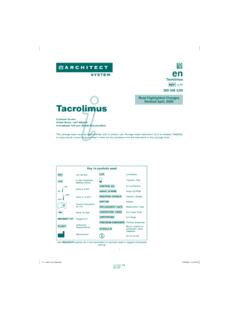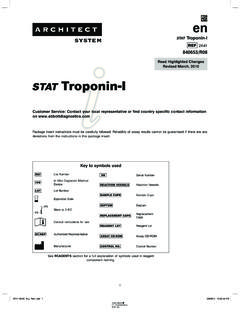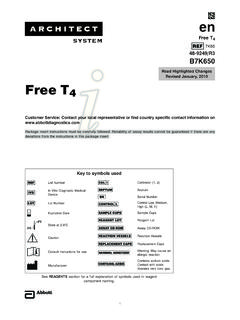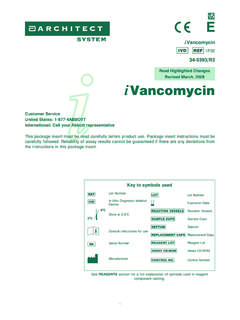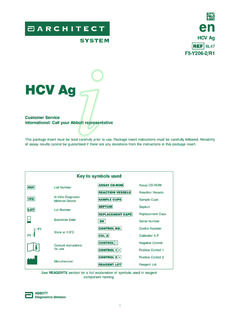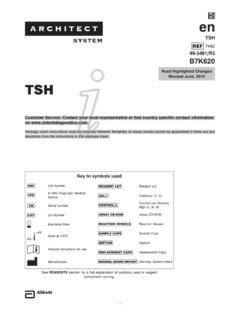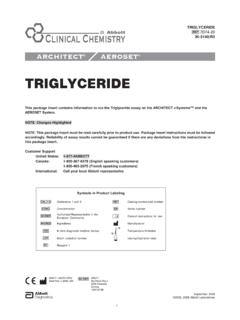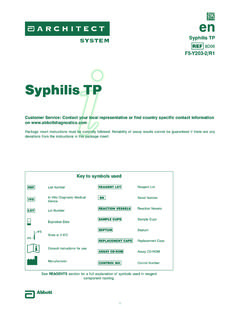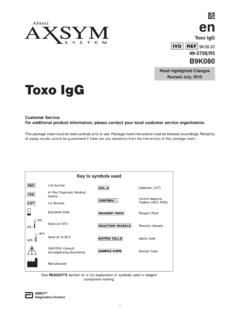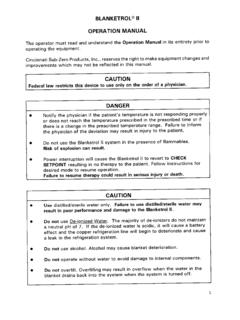Transcription of en - Ilex Medical Ltd.
1 1systemenRubella IgG 6C17840627/R3 Key to symbols usedList NumberIn Vitro Diagnostic Medical DeviceLot NumberExpiration DateCautionStore at 2-8 CConsult instructions for useManufacturerReagent LotSerial NumberReaction VesselsSample CupsSeptumReplacement CapsAssay CD-ROMC ontrol NumberWarning: SensitizerSee REAGENTS section for a full explanation of symbols used in reagentcomponent IgGRead Highlighted ChangesRevised September, 2009 Customer Service: Contact your local representative or find country specific contact information on insert instructions must be carefully followed. Reliability of assay results cannot be guaranteed if there are any deviations from the instructions in this package Rubella IgGINTENDED USEARCHITECT Rubella IgG is a chemiluminescent microparticle immunoassay (CMIA) for the quantitative determination and qualitative detection of IgG antibodies to rubella virus in human serum and plasma on the ARCHITECT i System.
2 The ARCHITECT Rubella IgG assay is intended to aid in the determination of immune status to AND EXPLANATION OF TESTP rimary postnatal rubella virus infection is typically a mild self-limiting disease characterized by a maculopapular rash, fever, malaise and In contrast to postnatal infections, primary prenatal infections may have devastating effects. In utero infections may severely damage the fetus, particularly if occurring during the first four months of gestation. The congenitally infected infant may exhibit one or more of a variety of defects collectively known as the congenital rubella syndrome (CRS). Among these are low birth weight, cataracts, deafness, congenital heart disease, and mental The World Health Organization (WHO) conducted a worldwide survey on rubella, CRS, and rubella vaccine in 1995 and 1996.
3 They reported an incidence of CRS of 60 to 220 cases with 100000 live births during epidemics in developing countries, a rate similar to those of industrialized countries before naturally acquired and vaccine induced immunity to rubella virus associated with antibody persistence have been shown to provide protection from clinical rubella upon The widespread use of highly effective and safe vaccines dramatically reduced the incidence of rubella and CRS in the United States. In spite of this reduction, rubella outbreaks continue to occur. The number of cases of rubella reported annually to the WHO Regional Office for Europe has remained fairly stable over the past decade, with 304320 cases reported during 2003.
4 These occurrences indicate a need for continued serological surveillance to identify susceptible individuals and reduce the potential risk to presence of at least 10 International Units (IU) of antibody per mL of sample is indicative of past exposure to rubella virus. Antibody levels below 10 IU/mL may be insufficient to provide protection from clinical illness upon exposure to rubella virus. 7 BIOLOGICAL PRINCIPLES OF THE PROCEDUREThe ARCHITECT Rubella IgG assay is a two-step immunoassay for the quantitative determination and qualitative detection of IgG antibodies to rubella virus in human serum and plasma using CMIA technology with flexible assay protocols, referred to as the first step, sample, assay diluent, and partially purified rubella virus coated paramagnetic microparticles are combined.
5 IgG antibodies to rubella present in the sample bind to the rubella virus coated microparticles. After washing, anti-human IgG acridinium-labeled conjugate is added to create a reaction mixture in the second step. Following another wash cycle, pre-trigger and trigger solutions are added to the reaction mixture. The resulting chemiluminescent reaction is measured as relative light units (RLUs). A direct relationship exists between the amount of IgG antibodies to rubella in the sample and the RLUs detected by the ARCHITECT i System additional information on system and assay technology, refer to the ARCHITECT System Operations Manual, Section Kit, 100 Tests/500 TestsNOTE: Some kit sizes are not available in all countries or for use on all ARCHITECT i Systems.
6 Please contact your local Rubella IgG Reagent Kit (6C17) 1 bottle ( mL per 100 test mL per 500 test bottle) partially purified rubella virus coated microparticles in TRIS buffer with surfactant. Preservatives: sodium azide and ProClin 950. 1 bottle ( mL per 100 test mL per 500 test bottle) Anti-human IgG (mouse, monoclonal) acridinium-labeled conjugate in MES buffer with surfactant and protein (bovine) stabilizer. Minimum concentration: 16 ng/mL. Preservatives: antimicrobial agents. 1 bottle ( mL per 100 test mL per 500 test bottle) Assay Diluent in TRIS buffer with surfactant and protein (bovine, goat, mouse) stabilizers.
7 Preservatives: ProClin 950 and ProClin DiluentARCHITECT i Multi-Assay Manual Diluent (No. 7D82-50) 1 bottle (100 mL) ARCHITECT i Multi-Assay Manual Diluent containing phosphate buffered saline solution. Preservative: antimicrobial ReagentsARCHITECT i Pre-Trigger SolutionPre-trigger solution containing (w/v) hydrogen peroxide. ARCHITECT i Trigger SolutionTrigger solution containing N sodium hydroxide. ARCHITECT i Wash BufferWash buffer containing phosphate buffered saline solution. Preservatives: antimicrobial AND PRECAUTIONS Package insert instructions must be carefully followed. Reliability of assay results cannot be guaranteed if there are any deviations from the instructions in this package Precautions CAUTION: This product contains human sourced and/or potentially infectious components.
8 Refer to the REAGENTS section of this package insert. No known test method can offer complete assurance that products derived from human sources or inactivated microorganisms will not transmit infection. Therefore, all human sourced materials should be considered potentially infectious. It is recommended that these reagents and human specimens be handled in accordance with the OSHA Standard on Bloodborne Biosafety Level 2 9 or other appropriate biosafety practices10,11 should be used for materials that contain or are suspected of containing infectious Microparticles contain methylisothiazolones, which are components of ProClin, and are classified per applicable European Community (EC) Directives as: Irritant (Xi).
9 The following are the appropriate Risk (R) and Safety (S) cause sensitization by skin contact with material and its container must be disposed of in a safe suitable swallowed, seek Medical advice immediately and show this container or Assay Diluent contains methylisothiazolones, which are components of ProClin, and are classified per applicable European Community (EC) Directives as: Irritant (Xi). The following are the appropriate Risk (R) and Safety (S) to cause sensitization by skin contact with case of contact with eyes, rinse immediately with plenty of water and seek Medical material and its container must be disposed of in a safe Wear suitable gloves and eye/face swallowed, seek Medical advice immediately and show this container or product not classified as dangerous per European Directive 1999/45/EC as amended - Safety data sheet available for professional user on product contains sodium azide; for a specific listing, refer to the REAGENTS section.
10 Contact with acids liberates very toxic gas. This material and its container must be disposed of in a safe information on the safe disposal of sodium azide and a detailed discussion of safety precautions during system operation, refer to the ARCHITECT System Operations Manual, Section PrecautionsDo not use reagent kits beyond the expiration date. Do not pool reagents within a kit or between reagent kits. Before loading the ARCHITECT Rubella IgG Reagent Kit on the system for the first time, the microparticle bottle requires mixing to resuspend microparticles that have settled during shipment. For microparticle mixing instructions, refer to the PROCEDURE, Assay Procedure section of this package MUST be used to prevent reagent evaporation and contamination and to ensure reagent integrity.
